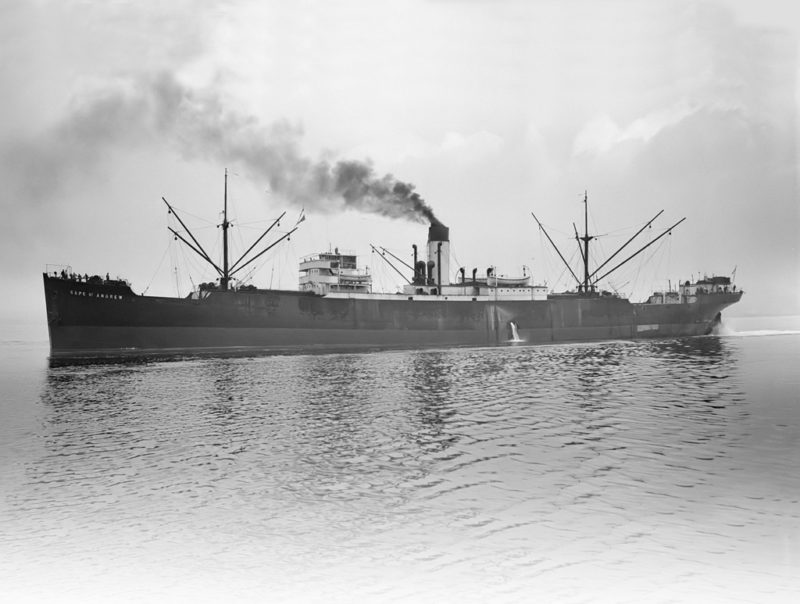
Robert Rankin was trading wooden sailing ships from Liverpool to North America in the 1850s and the extent of his involvement in shipping is shown by his appointment as Chairman of the Mersey Docks and Harbour Board in 1862/63.
He then took a partner named Gilmour under the style of Rankin, Gilmour & Company, and by 1880 they were trading six iron sailing ships with Saint names from their office in South John Street, Liverpool along with the composite half-wooden half-iron Duke of Edinburgh to North America. The Liverpool shipyard of Royden & Sons completed their first steam tramps in 1880, Saint Albans and Saint Bernard and Saint Columba, while Andrew Leslie completed Saint Dunstan on the Tyne and Earle & Company completed the twin-funnelled Saint Ronans at Hull in 1881. The latter pair passed to the liner services of Prince Line Ltd. and Furness, Withy & Co. Ltd. in 1893/94.
Their first triple-expansion powered tramp was delivered in January, 1886 as Saint Oswald from the famous Tyneside yard of Armstrong, Mitchell & Co. Ltd., which six months later completed the world’s first bulk-oil tanker for German owners, Gluckauf. Saint Oswald was the first of thirty such steam tramps completed over the next twenty years for the Liverpool owners by shipbuilders all over Britain. They were registered under single-ship limited liability companies until 1890 when the British & Foreign Steamship Co. Ltd. was formed, later renamed Saint Line Ltd.
The Saint Line ships were shelter-deckers and were well used on charter to the liner trades.
Saint Pancras was wrecked in June 1895 on Samarang Bank near Labuan while on a voyage from Manila to Marseilles and Liverpool with sugar, copra and hemp.
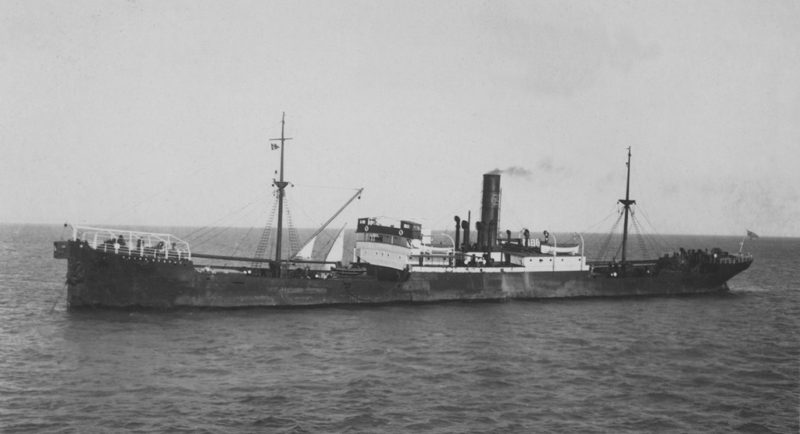
Saint Andrew was completed in 1899 by C.S. Swan & Hunter as a larger four-masted twin-screw cargo-liner for Transatlantic services, and was used as a transport in the Boer War. After her sale in 1911 to Hamburg America Line as Bermuda she continued sailing on the North Atlantic and was ceded to Britain on 20th March 1919 under the management of Lawther, Latta, becoming Englestan in 1923 before passing to the Italian register and being broken up at Genoa in October 1932. Saint Cuthbert of 1895 stayed with Merseyside owners T. & J. Harrison after her sale in 1902 as Chancellor, with Saint Regulus and Saint Mary also sold to Liverpool owners around this time. Marine casualties included Saint Kilda sunk by Russian warships near Hong Kong in June 1905 while on a voyage from Hong Kong to Yokohama with jute, rice and cotton. The Russians alleged she was carrying contraband of war to their enemies in Japan. Saint Cuthbert was destroyed by fire off Cape Sable in February 1908 while on a voyage from Antwerp to New York with general. The White Star liner Cymric of 1908 took off 35 crew but 15 men who had put out in a boat were drowned when it capsized in heavy seas.
The Saint Line fleet had reached a strength of fifteen tramps with the delivery of Saint Michael of 1907, but poor subsequent freight rates kept the fleet at this strength until the first of sixteen new tramps was ordered in 1910 from Clydeside yards:-
16 STEAM TRAMPS OF 7,000-9,000dwt
Russell & Co., Port Glasgow – (8) Saint Bede, Saint Dunstan, Saint Ursula, Saint Winifred, Saint Egbert, Saint George, Saint Hugo, Saint Jerome
William Hamilton & Co., Port Glasgow – (6) Saint Ronald, Saint Kilda, Saint Leonards, Saint Stephen, Saint Theodore, Saint Quentin
Archibald Mcmillan & Son, Dumbarton (2) Saint Andrew, Saint Hugo
In addition the Wear-built Arab, completed in 1912 for the Bedouin Steam Navigation Co. Ltd. Of Liverpool (W. & R. Thomson), was purchased in 1913 and renamed Saint Veronica, and the Russell built Hawkhead of Crawford & Rowat, Glasgow was then purchased and renamed Saint Fillans in 1916. They were all three-island shelter-decker tramps with five holds, no. 3 hold being smaller than the others but serving as a cross-bunker hold and full of coal for long voyages.
Saint Stephen was to have the longest career of 57 years keeping her name under the Finnish flag before passing to Brazil in 1949 and foundering 75 miles west of ltapua Lighthouse while on a voyage from Macau to Santos on 25th May 1968.
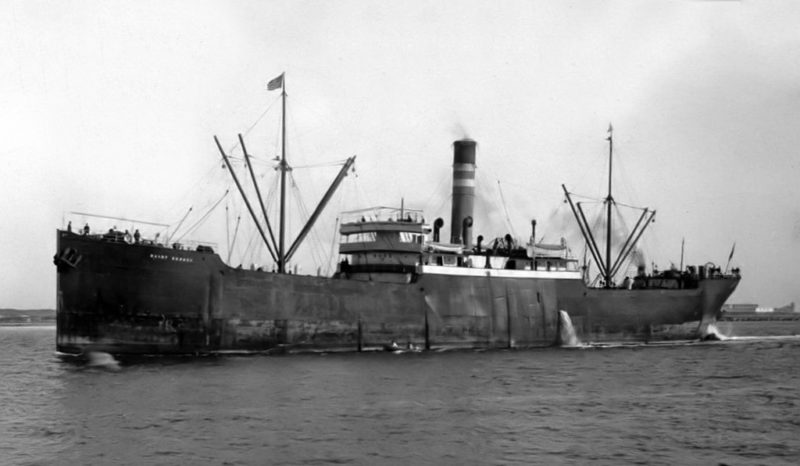
Saint Egbert under Capt. William Barr was bound to New York from Colombo with sugar and general cargo when she was intercepted by the German cruiser Emden on 18th October 1914 to the west of Cape Comorin in Southern India. Her American cargo was neutral and the tramp was kept afloat as a prize for holding captured crews until she was sent into Cochin with nearly 600 men onboard two days later.
The Saint Line fleet had reached a strength of twenty tramps shortly after the outbreak of WWI, and was to be comparatively lucky during this time. Saint Leonards was mined in the English Channel on 15th November 1916 but reached Le Havre safely.
Three tramps only were lost to the enemy from this large fleet:-
12.12.1916 Saint Ursula – Torpedoed and sunk 45 miles SSE of Malta by U-32, on a voyage from Salonica to Newport News in ballast, 4 lost.
12.2.1917 Saint Theodore – Sunk by Moewe having been captured two months earlier 520 miles SW of Flores.
19.9.1917 Saint Ronald – Torpedoed and sunk 95 miles NNW of Tory Island by U-82 on a voyage from Antofagasta and Norfolk(Va) to Liverpool with nitrate, 24 lost.
Saint Kilda of 1911 was wrecked on Little Miquelon, Newfoudland on 9th December 1915, and Saint Oswald of 1905 was sunk by collision off Pelaho Point on the last day of 1915. Three of the fleet were converted into tankers.

Saint Dunstan of 1900 had been sold to John I. Jacobs in 1912 to become his Beechwood and survived the war carrying molasses from the West Indies to Britain, Saint Fillans of 1900 was sold to the Anglo-American Oil Co. Ltd. in 1915 and renamed Spiraea but was lost by fire in the Manchester Ship Canal on 29th February 1916, Saint Egbert of 1904 had been sold to the Anglo Saxon Petroleum Co. Ltd. shortly before the outbreak of war and survived as Physa.
Saint Fillans was missed by a torpedo in the English Channel on 21st October 1917, but other Merseyside owners had not been so lucky, in particular T. & J. Harrison.
- They had lost 27 ships and began purchasing the first of twelve Saint Line ships towards the end of 1917 and throughout 1918. They were renamed:-
- Saint Leonards as Spectator
- Saint Bede as Dictator
- Saint Veronica as Matador
- Saint Fillans as Orator
- Saint Dunstan as Instructor
- Saint Andrew as Sculptor
- Saint Winifred as Electrician
- Saint Egbert as Author
- Saint George as Statesman
- Saint Quentin as Gladiator
- Saint Hugo as Barrister
- Saint Jerome as Patrician
Three of these were lost during 1918, Sculptor, Barrister and Instructor with the latter in collision with the U.S. transport America in the Western Approaches on 15th July. There were only three survivors of the pre-war Saint Line fleet at the end of the war, Saint Patrick of 1906, Saint Michael of 1907 and Saint Stephen of 1911. The main directors of the Saint Line at this time were Robert and John Rankin, sons of the founder, who had left a large fortune in his will. Robert junior was also a director of the Pacific Steam Navigation Company and of the Midland Railway.
His country residence was at Rufford Old Hall in Lancashire, now a National Trust property. John Rankin had taken a science degree at Trinity College, Cambridge and had represented Leominster & Herefordshire in the House of Commons since 1880.
He was Chairman of the Shipwreck & Humane Society and his country residences were at Lyston Court and Bryngwyn in Wales.
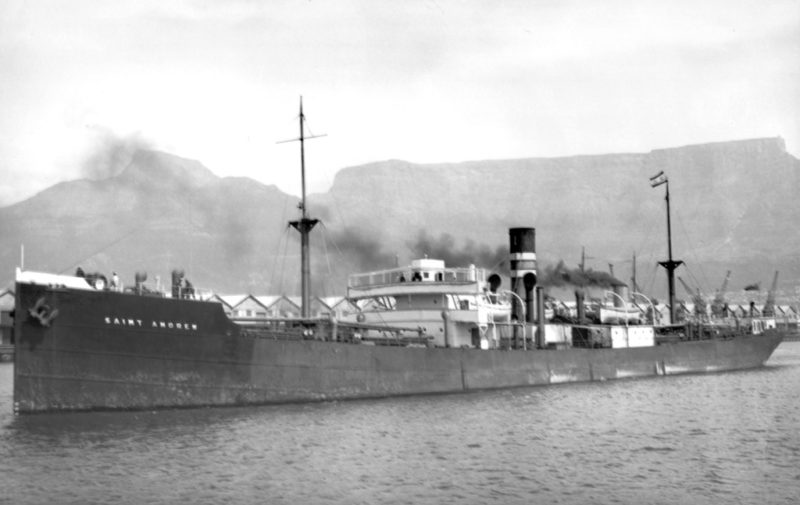
Three standard ‘War’ tramps were purchased during 1919, two of these being to a special ‘F1’ design of shelter-decker tramp and unique to their builder, Northumberland Shipbuilding Co. Ltd. of Howden-on-Tyne. War Keep was renamed Saint Dunstan and War Turret was renamed Saint Andrew, and they were traded throughout the lean 1920s after the war survivors had been sold off.
Saint Michael of 1907 was sold to Glen & Company in 1920 and renamed Aboukir, Saint Stephen of 1911 was sold to Finnish owners and Saint Patrick of 1906 to Belgian owners although she took a Dutch name Scheldedijk under Scheldestroom Maats.
One new tramp was ordered from the Duncan yard on the Clyde and completed as Saint Oswald in 1925, but had only a career of four years for Saint Line before she was sold to French owners but came back under the Red Duster as Dunstan for Booth Line in 1935.
The war standard Saint Bede was sold to T. & J. Harrison in 1924 and became their Musician until 1938, thus leaving only two tramps in the Saint Line fleet at the start of the Depression, Saint Dunstan and Saint Andrew.
The subsequent disastrous trading resulted in the sale of Saint Line in 1937 to Mitchell Cotts & Co. Ltd. and transfer of management to London.
MITCHELL COTTS & Co. Ltd.
William Mitchell Cotts was a Scotsman who went to South Africa before the turn of the century and established the Natal Collieries. These collieries needed a supply of pitprops and Baltic timber was imported in tramps owned by his Sun Shipping Co. Ltd. He suffered two war losses during WWI with the 3,085grt, 1894 built Julia Park, purchased from Park Steamship Co. Ltd. (J. Smith Park of Glasgow) on 30th May 1916, and the 3,194grt 1886 built Lord Charlemont, purchased from the Irish Shipowners Co. Ltd. (T. Dixon & Sons of Belfast) on 19th April 1918. He also had at this time four tramps under his South African subsidiary British Africa Shipping & Coaling Co. Ltd., and half a dozen coasters trading under Thesen’s Steamship Co. Ltd. under the South African flag. He purchased three large War ‘A’ class as replacements in 1919 renaming them Cape of Good Hope, Cape Colony and Cape Natal but sold the trio in December 1920 to the Union Steamship Co. Ltd. of New Zealand. Two of these, Aroona and Kaikorai, survived WWII to be sold to the Chinese register.

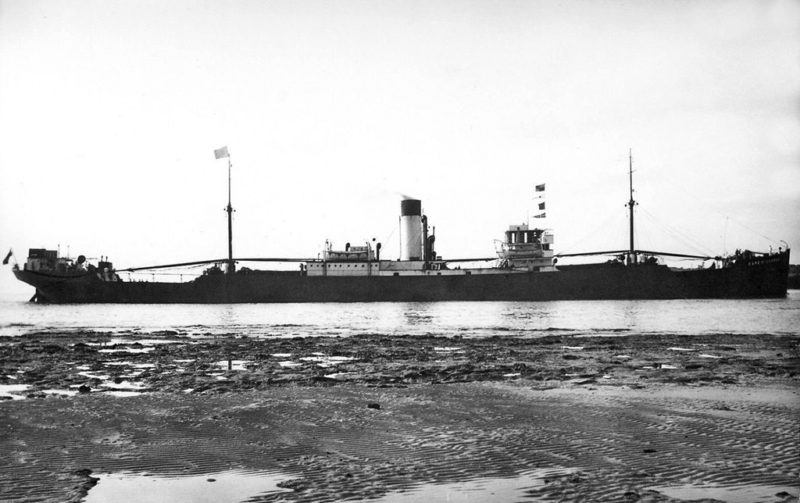
After the death of Sir William Mitchell Cotts, his son Crichton Mitchell Cotts steered the Sun Shipping Co. Ltd. through the difficult 1920s and owned seven big tramps at the beginning of the Depression in 1930:-
CAPE CROSS
4,081grt, built in 1910 by the Rickmers shipyard at Bremerhaven as Lilly Rickmers, She was a war prize as Hans-Wilhelm Hemsoth. She was broken up at Shanghai in March 1934.
CAPE ST. AGNES
5,191grt, built in 1918 by Greenock & Grangemouth Dockyard Co. as War Briton, later named Titan.
CAPE ST. COLUMBA
5,838grt, built in 1917 was built by Northumberland Shipbuilding at Howden as Carlow Castle of Union-Castle Line, becoming Cape St. Columba in 1930. In 1935 she was sold to Carras Brothers of Chios and renamed Adelfotis and in May 1943 she was torpedoed and sunk by U-182 in the Atlantic Ocean.
CAPE ST. FRANCIS
3,549grt, built in 1908 was built by Charles Connell & Co. at Scotstoun as Sutlej for Nourse Line and purchased for £9,000 in 1929. She was sold to T.G. Paterson of London in 1932 and broken up in Bombay in 1948.
SUNLAND
4,879grt, built in 1918 by John Priestman & Co. at Southwick, Sunderland. She was sold to N.D. Lykiardopulo in 1934 and renamed Daphne and in 1939 she was sold to G.N. Embiricos and renamed Embiricos Nicolaos. In March 1941 she was bombed and sunk by German Ju-88 aircraft south of Crete.
CAPE ST. ANDREW
5,094grt, built in 1928 by R.Duncan & Co. at Port Glasgow.
CAPE ST. GEORGE
5,112grt, built in 1928 by R.Duncan & Co. at Port Glasgow. In August 1940 she sank after a collision with the Yugoslav 4,162grt SS Rad off West Africa.
On the sale of Saint Line to Mitchell Cotts & Co. Ltd. Cape St. Agnes was transferred from the Sun Shipping Co. Ltd. to Saint Line Ltd. as Saint Agnes, both of these companies being managed from the same London office and owning on the takeover:-
Saint Line Ltd.
Saint Agnes 5,191/1918
Saint Anselm 5,616/1919
Saint Dunstan 5,662/1919
Saint Germain 1,036/1924
Sun Shipping Co. Ltd.
Cape St. Andrew 5,094/1928
Cape St. George 5,112/1928
Saint Andrew had been renamed Saint Anselm shortly before the take-over,and the smaller oil-engined Saint Germain had been purchased in 1935 from French owners, having been built in Sweden as Epoca for P.G. Thulin of Stockholm in 1924. The same fleet was owned on the outbreak of war, with hostilities almost completely wiping out the fleet:-
27.8.1940 Saint Dunstan – Torpedoed 25 miles NE of Malin Head by U-57 on a voyage from Glasgow to Baltimore in ballast, 14 lost.
14.9.1940 Saint Agnes – Sunk by gunfire from Italian submarine Emo off Portugal on a voyage from Vizagapatnam and Table Bay and Freetown to Methil and Hull with linseed, castor seed and manganese ore.
13.11.1940 Cape St. Andrew – Torpedoed and sunk by U-137 west of Malin Head on a voyage from the Tees to Bombay in ballast, 15 lost.
17.11.1940 Saint Germain – Torpedoed and sunk by U-137 west of Malin Head on a voyage from Leixoes to Port Talbot with pitprops.
30.6.1941 Saint Anselm – Torpedoed and sunk by U-66 south of the Azores on a voyage from Calcutta to Hull with pig iron, linseed and groundnuts, 34 lost.
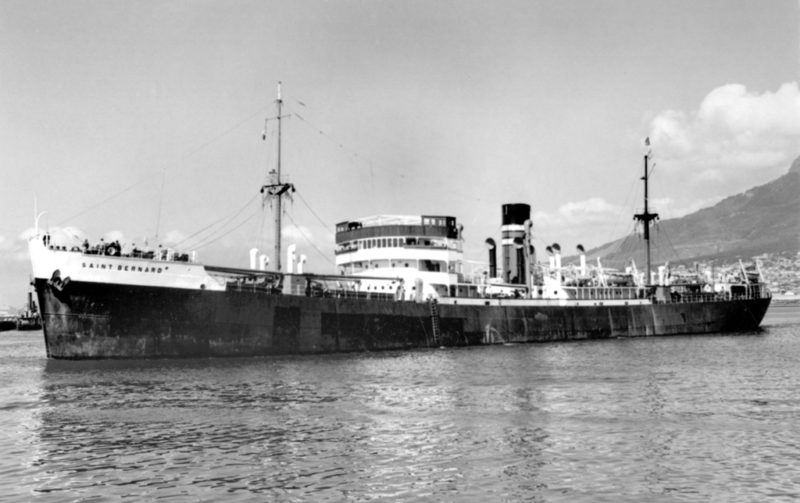
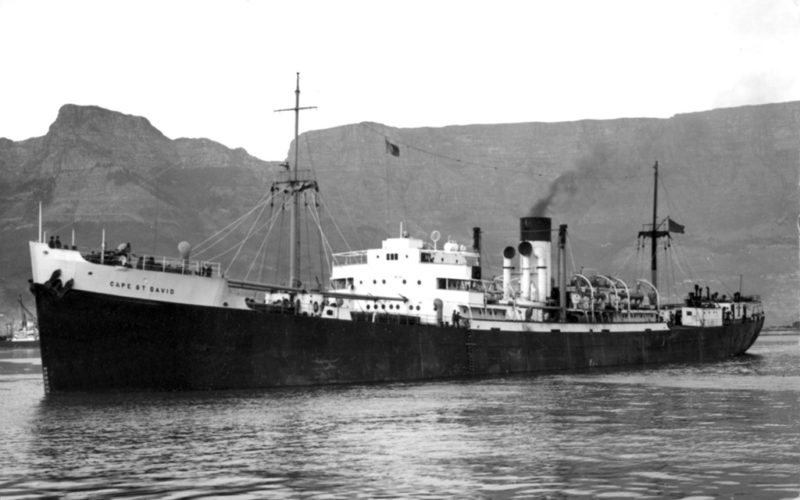
The first loss was Saint Dunstan when torpedoed 25 miles NE of Malin Head by U-57 when outward bound from Glasgow to Baltimore in ballast and 14 crew were killed in the explosion. The old tramp was still afloat on the 26th and was taken in tow but sank off the Isle of Arran on the 27th before she reached the safety of the Clyde.
Saint Agnes was lost next in the homeward-bound convoy SLS46 from Freetown, and Saint Anselm was lost in a similar convoy. She was sailing a few hours ahead of SL76 on the last day of June 1941 to the SW of Madeira when U-66 suddenly surfaced and fired a spread of four torpedoes. These all missed their target due to bad aiming or the Saint Line ship’s continual zigzagging, and a further two torpedoes were fired without result. U-66 then started to shell the tramp killing 34 of her crew in the process and starting a fire to add further danger to the carnage. The remaining crew got away in the only lifeboat and spent an agonising 18 days in the open boat before being picked up by a Spanish ship.
Cape St. George had become a marine loss in 1940. However one Saint Line ship was lucky throughout the war. This was the new Saint Bernard delivered in September 1939 from W. Hamilton at Port Glasgow shortly after the declaration of war. She tramped on after the war until her sale to Soc. Commerciale Antoine Vloeberghs SA of Belgium owners in 1956. She was renamed Jean Marie, then in 1962 she was sold to Argo (Hellas) Shipping Co. Special SA of Piraeus and was renamed Aristos. In August 1967 she sank after a collision with the Norwegian 13,692grt Linde 16 miles off Beachy Head while on a voyage from Antwerp to Piraeus.
Ocean Vista was managed from new in 1942 and was purchased in 1948 and renamed Saint Edmund, together with two standard ‘Empires’ renamed Saint Gregory for Saint Line and Cape St. David for the Sun Shipping Co. Ltd.
Empire Heywood became Saint Gregory, and her one claim to fame came shortly before her purchase while taking part in the evacuation of Jewish immigrants from British-controlled Palestine. On 18th August 1946 an explosion occurred in Haifa Bay while en-route to Cyprus with 750 immigrants. The explosion was from gelignite concealed in electric torches and caused delay more than damage and the tramp proceeded to Cyprus with her unfortunate cargo.
Fort Rouille was taken on a five-year bare-boat charter by Mitchell Cotts & Co. Ltd. in 1946, and traded alongside the four owned tramps.
Saint Bernard was sold to Belgian owners in 1956, with the last trio Cape St. David, Saint Edmund and Saint Gregory lasting until sold to Italian and Hong Kong owners in 1960 and 1962 respectively. Mitchell Cotts & Co. Ltd. had begun a policy of diversification in the 1950s over a wide field including engineering and large-scale project work.
Today Mitchell Cotts & Co. Ltd. is one of the most recognized and respected names in the shipping, freight forwarding and warehousing and transport business. They offer a total logistics solution for the movement of goods into and out of the East & Central Africa through their network of selected international business partners.
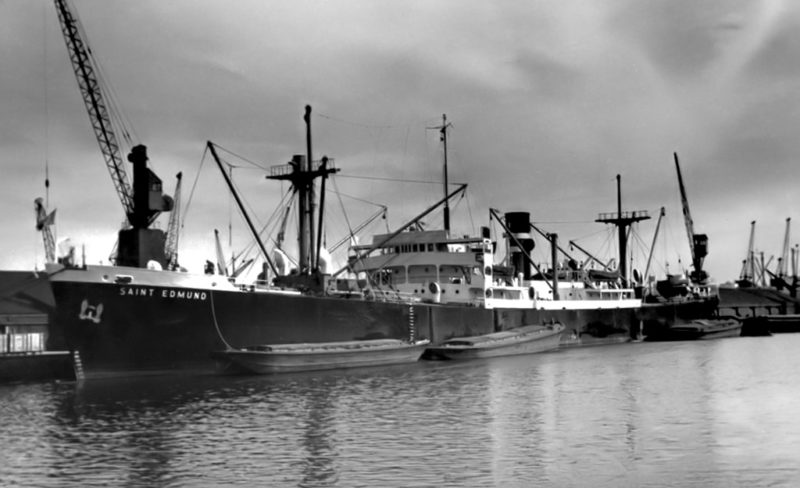

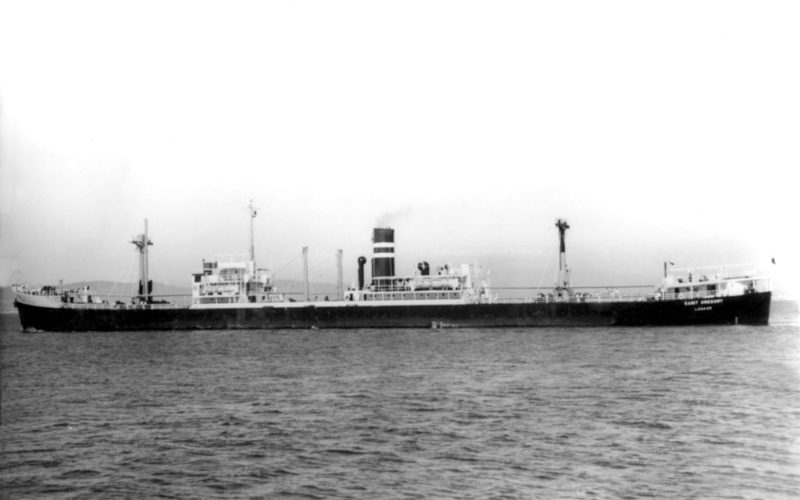
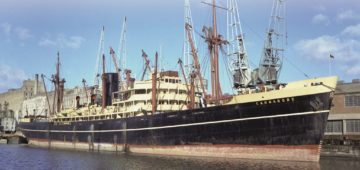



Comments
Sorry, comments are closed for this item